Nowadays, most people cannot imagine a life without an Internet. Some argue that after the Gutenberg printing press in the 1400s, no invention was more revolutionary than the Internet. Now, once you click the mouse, the world can be at your fingertips if you can use the mouse, see the screen and hear the audio. In other words,as long as you don't have any obstacles. As Istanbul Kültür University Information Systems and Technologies Department, we carry out our activities in line with this fact by considering the needs of disabled individuals.
Accessibility works that we implement on our web sites;
- The <h2> tag should be used for page titles.
This is one of the most important criteria for accessibility since the electronic readers used for visually impaired people perceive the topics on the website with this tag.
- The <blockquote> tag should be used for paragraphs to be highlighted.
The paragraphs to be considered are used to distinguish the relevant text from the others.
- For each image entered, one-word keyword related to the image should be entered in the alt tag field.
Especially for the visually impaired, each image contains keywords that describe the image, making the content more understandable. For SEO, it allows the website to be indexed more healthily.
- The description field for each image entered must contain text related to the subject of the image.
Text and explanations called longdesc should be placed for graphics and figures on the page. At least sub-or title text descriptions of such items must be specified. This content allows SEO to index the website more healthy.
- Page content should not contain javascript, flash, or silverlight codes.
Page content should not contain javascript, flash, or silverlight codes.
- There must be a minimum of 7 px space between the page content and the image.
In order to make the contents of the page more comprehensible, the distance between the text and the visual should be created in accordance with the gap standards.
- The information, structure and links transferred should be understood by the program or presented in text form.
Redirects must be made using the <a href> tag in accordance with web standards, not redirected with javacript or server side languages.
- The contrast ratio of large-scale text and large-scale text images must be at least 3: 1. Foreground and background colors should be user-recognizable.
In order to make the page contents more understandable, the size difference between the text and the image must be 3: 1.
- The text should not be justified on either side.
The text should be left-aligned in order for readers to better analyze the relevant text (starting or ending points).
- Paragraph spacing must be at least 1.5 spaces and paragraph spacing must be at least 1.5 times the leading.
For readers and users to read the content more comfortably, the distance between texts should be in accordance with the standards.
- Web pages should not contain content that shines more than three times per second, or the glare should be below the “general glare” and “red glare” thresholds.
- There should be titles or labels indicating the purpose of the subject.
- Information about the user's current location between multiple Web pages should be presented.
- If text or links within the page are distinguished from each other using colors, then other visual aids should be used for people who have trouble seeing colors. (Ex: <h2>)
- All content on the web page should be operable with the help of the keyboard. In other words, the fields that can be clicked, links and form fields should be accessible using the keyboard.
- Disabled people should be given enough time to read the page content easily. When the user completes any form, when the user cannot complete the process due to timeout and returns to the form, the data in the fields that he has filled in should not be lost.
- Ability to skip repeating sections: When the user enters different links within the same page, he should be able to skip repeating sections on these pages and easily access the main content.


